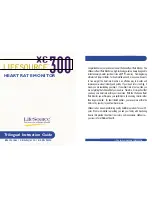
GB
5.0 Training instruction
For Your Safety:
> Before beginning your program of exercise, consult your
doctor to ensure that you are fit enough to use the equipment.
Base your program of exercise on the advice given by your
doctor. Incorrect or excessive exercise may damage your
health.
This home trainer has particularly been designed and deve-
loped for leisure time sportsmen. It is excellently suited for
cardiovascular training.
The training methodically has to be organised on the prin-
ciples of stamina training. This will predominantly cause
changes and adaptations of the cardiovascular system. This
includes the reduction of the resting pulse frequency and
of the load pulse.
This gives the heart more time for filling the ventricles and for
the blood circulation of the cardiac musculature (through
the coronary vessels). Moreover, depth of breathing and
the volume of air that can be breathed in (vital capacity)
are increased. Further positive changes take place in the
metabolic system. In order to achieve these positive changes,
the training has to be planned according to certain gui-
delines.
The intensity of training
When training with the home trainer, the intensity of training
on the one hand is regulated through the step frequency
and on the other hand through the step resistance. The
training person can adjust the step resistance via the
braking force regulation at the steering column. Always pay
attention to the fact not to overstrain yourself with regard
to intensity of training and to avoid overstress. Wrong or
excessive training may be prejudicial to health.
Therefore, during training check as to whether you have
correctly determined your training intensity on the basis of
your pulse frequency. A rule of thumb for an appropriate
pulse frequency is:
180 minus life age
This means that a 50 year old person, for example, should
organise his/her training at a pulse frequency of 130.
Training recommendations on the basis of this calculation are
considered to be favourable by numerous recognised
sports physicians. According to them you should determine
your step frequency and the pedalling resistance such that
you achieve your optimal pulse frequency according to the
above mentioned rule of thumb.
These recommendations, however, only apply to healthy
persons and are not valid for cardiovascular patients!
The exercise and load scope
Beginners should increase the load and intensity of their
training only step by step. The first training units should be
relatively short and organised in intervals.
Sports physicians consider the following load factors to be
positive for fitness:
Beginners should not start with training units of 30 to 60
minutes.
A beginner training could be organised as follows during the
first four weeks:
In order to have a personal training documentation, you can
enter the training values achieved in the performance
table.
Prior to and after every training unit gymnastic exercises lasting
approx. 5 minutes serve the warming up and/or cooling
down. There should be a day without training between two
training units, if you later on prefer to train three times a
week for 20 - 30 minutes each. Otherwise nothing can be
said against a daily training.
Frequency
Duration
daily
10 min
2-3 times weekly
20-30
min
1-2 times weekly
30-60
min
Frequency
Length of exercise blocks
three times a week
2 minutes training
1 minute break for gymnastics
2 minutes training
1 minute break for gymnastics
2 minutes training
three times a week
3 minutes training
1 minute break for gymnastics
3 minutes training
1 minute break for gymnastics
2 minutes training
three times a week
4 minutes training
1 minute break for gymnastics
3 minutes training
1 minute break for gymnastics
3 minutes training
three times a week
5 minutes training
1 minute break for gymnastics
4 minutes training
1 minute break for gymnastics
4 minutes training
4th week
3rd week
2nd week
1st week
7


























